For startup founders, one of the most critical decisions is how to fund their venture. Should they bootstrap, using personal resources and business revenue, or seek external fundraising? Each path has its unique benefits and challenges.
Understanding Bootstrapping
Bootstrapping involves starting a business using personal savings or revenue generated by the business. This approach has led to notable success stories, such as Mailchimp, which began in 2001 and grew into a substantial company without external funding. Dileep Rao’s “Bootstrap to Billions” offers insights and case studies of successful bootstrap companies.
The primary advantage of bootstrapping is maintaining full control and ownership. This path fosters a culture of resourcefulness and necessitates a focus on sustainable, customer-driven growth. However, bootstrapped businesses often face slower growth and cash flow challenges, as highlighted in the Global Entrepreneurship Monitor (GEM) report.
Understanding Fundraising
Fundraising includes securing funds from angel investors, venture capitalists, or through crowdfunding. Data from platforms like Crunchbase and PitchBook showcase successful fundraising stories and demonstrate how this path can accelerate growth and provide valuable resources and networks.
The benefits of fundraising are the quicker access to significant capital and resources for scaling. However, it often leads to equity dilution, potential loss of control, and the pressure to meet investor expectations, as noted in articles from Harvard Business Review.
Comparing the Two
Choosing between bootstrapping and fundraising depends on various factors, including the company’s stage, industry, market size, and the founder’s goals. Reid Hoffman, in his book “Blitzscaling,” discusses how a startup’s approach to growth might influence this decision.
The Kauffman Foundation’s research indicates that the funding choice impacts a startup’s long-term trajectory. Bootstrapping might lead to slower but more sustainable growth, while fundraising can propel rapid expansion with the potential loss of some strategic control.
Expert Perspectives
Podcasts like “How I Built This” with Guy Raz and “Masters of Scale” with Reid Hoffman offer insights from successful entrepreneurs. These accounts show the range of experiences and underline the importance of aligning funding choices with the startup’s vision and capabilities.
Practical Steps
For bootstrappers, effective financial management is critical, supported by resources from the U.S. Small Business Administration. For those seeking external funding, preparing a compelling pitch and understanding investor expectations is key.
The Role of neonVest
For startups considering fundraising, neonVest.com is a valuable resource. It connects startups with suitable investors, streamlining the fundraising process. For founders targeting rapid growth or requiring resources beyond what bootstrapping offers, neonVest is instrumental in facilitating efficient capital raising. The platform simplifies the complex fundraising landscape, allowing founders to focus on their core business.
In conclusion, whether to bootstrap or fundraise is a complex decision, dependent on various startup-specific factors. Bootstrapping offers control and gradual growth, while fundraising enables rapid expansion and resource acquisition. Aligning this decision with the startup’s long-term strategy is crucial. For those opting for fundraising, neonVest emerges as a key ally, providing support and connections for successful capital raising and business scaling.
In a market that is increasingly competitive and challenging, neonVest stands out by offering the insights, network, and tools necessary for startups to thrive and for investors to participate in transformative growth stories. Whether you’re on the brink of a breakthrough or seeking to back the next market leader, neonVest aims to be the partner that helps turn bold visions into valuation milestones.


